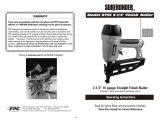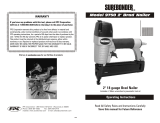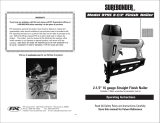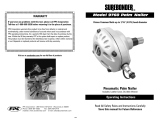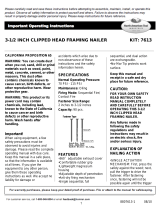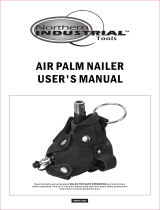Page is loading ...

®
FPC Corporation - 355 Hollow Hill Drive - Wauconda, IL 60084
Phone: (847) 487- 4583 Fax: (847) 487-0174
website: www.surebonder.com e-mail: [email protected]
Read All Safety Rules and Instructions Carefully
Save this manual for Future Reference
1211
Operating Instructions
0
21
®
21° Round Head 3-1/2" Framing Nailer
Includes: 3 Allen wrenches, open/closed end 8mm wrench & oil
Model 9772 Framing Nailer
WARRANTY
If you have any problems with this product, please call FPC
Corporation toll-free at 1-800-860-3838 before returning it to the
place of purchase.
FPC Corporation warrants this product to be free from defects in material and
workmanship, under normal conditions of use and when used in accordance
with FPC operating instructions, for a period of 90 days from the date of
purchase by the user. Within the 90 day warranty FPC at its option shall repair
or replace this product. Product must be returned at the distributor/user
expense, either within warranty or out. Repaired or replaced product will
receive a 60 day warranty. USER MUST BE USING THE PROPER NAILS FOR
THIS WARRANTY TO BE VALID. WARRANTY IS VOID IF INCORRECT TYPE OF
NAILS ARE USED.
Round Head
Plastic Collated Nails
2” thru 3-1/2”
Visit us at surebonder.com for our full line of products

To order parts go to: www.surebonder.com
THE SAFETY WARNINGS BELOW CANNOT COVER ALL POSSIBLE SITUATIONS THAT MAY
OCCUR. THESE BASIC SAFETY PRECAUTIONS SHOULD ALWAYS BE FOLLOWED TO PROTECT
AGAINST PERSONAL INJURY TO THE OPERATOR OR OTHER PERSONNEL IN THE AREA, AS
WELL AS DAMAGE TO THE EQUIPMENT. READ AND UNDERSTAND THESE WARNINGS BEFORE
USING EQUIPMENT.
Keep tool away from children, and DO NOT allow children near work area. Do not allow children
or untrained personnel to handle this nailer.
DO NOT operate this nailer while tired, or under the influence of drugs, alcohol, or medication
that makes you drowsy.
Never point the nailer at yourself or others - always assume that the nailer is loaded, and
proceed with caution.
Wear safety glasses and ear protection. The nailer operator and all personnel in the work area
must wear safety glasses that protect the front and side, to avoid eye injury. Ear plugs should
be worn to avoid hearing damage.
If operator will be working in a situation where overhead work will be done (i.e. on a ladder,
stairs, or scaffolding) a hard hat must be worn.
Never wear loose clothing or jewelry because it can get caught in the moving parts of this nailer.
Make sure long hair is covered, to avoid getting it caught in nailer.
Keep the nailer pointed away from yourself and others at all times. Keep hands and all body
parts away from rear area of nailer (near air hose) to guard against injury. Keep hands and feet
away from firing head during use.
Keep proper balance and footing at all times - do not over-reach.
Never use oxygen, bottled gas or any type of combustible fuel as a power source - it can cause
an explosion and serious injury.
Do not use near flammable liquids or gases - the nailer sparks during operation, and could cause
an explosion and serious injury.
Use an air hose that will withstand at least 150 psi, OR 150% of the maximum pressure of the
compressor.
Never connect this tool to compressed air if the pressure could exceed 200 psi, as the nailer
could burst. Use only clean, dry, regulated compressed air, with pressure not exceeding 120 psi.
Do not use a non-relieving coupler with this nailer - if used, the nailer could remain charged with
air after disconnecting, and would still be able to drive a nail even after being disconnected. The
nailer and air hose must have a coupling so that all pressure is removed from the nailer when the
coupling is disconnected.
Do not depress the trigger or safety mechanism while loading nails - accidental firing of a nail
can occur. Keep your fingers away from the trigger when not firing nails. Always keep the nailer
pointed downward during loading.
Do not use an air hose that is too long - nailer operator can trip over it. Make sure all
connections are tight.
(WARNINGS continued next page)
Improper use of this nailer can result in death or serious injury.
This manual contains important information about product safety.
Read and understand this entire manual before operating this nailer
IMPORTANT SAFETY WARNINGS:
! DANGER
1
10
Dia.
Part
No.
No.
Description
4 9772-4 EXHAUST DEFLECTOR
8 9772-8 CAP
11 9772-11 PISTON RETAINER
15 9772-15 PISTON HEAD
21 9772-21 CYLINDER
26 9772-26
HOUSING LOWER REMOTE
29 9772-29 REMOTE HOUSING
32 9772-32 REMOTE CORE
35 9772-35 TRIGGER
38 9772-38 BUSHING
39 9772-39 NYLON NUT
44 9772-44 SAFETY COVER
46 9772-46 CATCH SUPPORT(B)
48 9772-48 CATCH SUPPORT(A)
49 9772-49 NO MAR PAD
50 9772-50 SPRING PAD RETAINER
55 9772-55 BODY
57 9772-57 GUIDE BODY
61 9772-61 TAIL COVER
68 9772-68 MAGAZINE SUPPORT
70 9772-70 TAIL COVER
71 9772-71 RELEASING BLADE
73 9772-73 FEEDER CLIP
74 9772-74 MAGAZINE
75 9772-75 MAGAZINE GASKET
77 9772-77 STOPPER
79 9772-79 PUSHER
80 9772-80 ROLLER
85 9772-83 COLLAR
86 9772-84 AIR PLUG
43 9772-43 TRIGGER
SOLD SEPERATELY
PARTS
Description
Description
O-RING 16*1.7
SCREW 5*16
GASKET
WASHER
O-RING 40*2.65
WASHER
O-RING56.7*2.9
SCREW 6*35
O-RING42.9*4.8
WASHER
SEAL,AIR
WASHER
O-RING 58*2
SPRING
BUMPER(A)
CONICAL SPRING
BUMPER(B)
RELEASING BLADE
O-RING16*1.8
SCREW 5*18
O-RING19*2.3
WASHER
O-RING5.6*1.8
PIN 3*14
O-RING8*1.8
SPRING PIN 3*16
O-RING 2.3*1.4
SPRING
SEAL,AIR
SPRING PIN 3*32
O-RING 89*2.9
SCREW 5*12
O-RING
SPACER
GASKET
GRIP
WASHER
SPRING
SCREW 5*25
WASHER
SCREW 5*14
Description
SCREW 5*12
O-RING42.9*4.8
FEEDER SHOE STOP
PISTON HEAD
SCREW8*25
DRIVER BLADE
RIVET
RIVET
PIN
STEEL BAR
13
No.
1
2
5
14
Fastener Kit #9772-420
Diagram
No.
Seal Kit #9772-400
3
9
Diagram
16
19
25
27
20
22
23
24
Diagram
56
62
No.
16
28
30
33
51
31
34
36
37
6
7
10
12
18
45
47
52
53
54
58
17
Drive Pin Kit #9772-410
59
60
63
64
40
41
42
65
66
67
69
72
76
SPRING
SPRING
PIN
SPRING
SCREW 4*8
78
84
81
83
82

Disconnect air hose from nailer:
before performing maintenance.
when clearing a jam.
when tool is not in use.
when moving it to another location.
when handing nailer to another person.
DO NOT place finger on trigger when disconnecting air hose - the nailer could fire when
reconnected to the air supply.
Carry nailer by the handle only, not by the air hose.
Do not drive nails close to the edge of the workpiece. It could split, allowing a nail to fly
or ricochet and causing personal injury. Do not try to drive nails at too steep an angle.
Make sure nailer is held firmly during firing to minimize recoil.
Do not drive a nail into very hard material, thin material, or on top of an existing nail- the
nail could ricochet, causing personal injury.
Never use the nailer if it is leaking air, the contact safety mechanism is not working,
nailer has missing or damaged parts, or requires repair. Make sure all screws and caps
are securely tightened.
Inspect the nailer before each use to insure that the trigger, safety mechanism, and
spring are operating properly. Lock the nailer in a clean, dry storage area between uses.
Choice of triggering method is important. See “Mode of Operation” instructions.
Only use parts, nails, and accessories supplied or recommended by FPC Corporation.
Unauthorized parts or fasteners can lead to malfunction and serious injury. Only
personnel trained by FPC Corporation or the distributor shall repair the product Do not
modify this tool in any way.
Never use in presence of flammable liquids or gases. The nailer produces sparks during
operation.
Never use the nailer in sites containing lacquer, paint, benzine, thinner, gasoline, gases,
adhesive agents, and other materials which are combustible or explosive.
Check for live wires. Avoid the risk of electrical shock by checking for live wires that may
be hidden by walls, floors, or ceilings. Turn off the breaker switch pertaining to that work
area.
Do not store the nailer in a cold weather environment.. Keep the nailer in a warm area
until the start of work. If it is in a cold area, bring it in a warm area and allow it to warm
up before use.
Manufacturer assumes no responsibility for consequential or indirect damages from the
use of this product.
Save this manual and have it available for tool operators
reference!
IMPORTANT SAFETY WARNINGS: continued
California Proposition 65
You can create dust when you cut, sand, drill or grind materials such as: wood,
paint, metal, concrete, cement, or other masonry. This dust often contains chemicals
known to cause cancer, birth defects or other reproductive harm. Wear protective gear.
9
2

Inspecting the magazine
Disconnect the air hose. Keep magazine and nose of tool clean and free of any dirt, lint or
abrasive particles. Clean the magazine by removing plastic tips or wood chips which may have
accumulated in the magazine. Lubricate it with pneumatic tool lubricant.
Storing
When not in use for an extended period of time apply a thin coat of pneumatic tool lubricant to
the steel parts in order to avoid rust. Do not store the nailer in a cold weather environment.
Keep the nailer in a warm and dry place.
Troubleshooting
The following form lists the common operating system with problems and solutions. Please
read the form carefully and follow it.
WARNING: If any of the following symptoms appears during your operation, stop using the tool
immediately, or serious personal injury could result. Only a qualified persons or an authorized
service center can perform repairs or replacement of tool. Disconnect tool from air supply
before attempting repair or adjustment. When replacing O-rings or cylinder, lubricate with
air tool oil before assembly.
Problem
Nailer operates but no nail is
driven.
Week drive. Slow to cycle.
Drives too deep.
Skipping nails, Intermittent
feed.
Nails jam, Driven nail is bent
Drives properly at normal
speed but does not drive fully
drive at faster nailing speed.
Check
Check for jam
Check feeder function
Ribbon spring damaged or week?
Check for proper nails
Check air pressure
Drive blade worn?
Piston O-ring worn or damaged?
Check air pressure.
Check for proper nails.
Check nail feeder function
Ribbon spring worn or damaged?
Piston O-ring cut or worn out?
Drive blade worn?
Check inside hose diameter.
Correction
Clear a nail jam.
Clean and lubricate.
Replace ribbon spring.
Use correct nails.
Increase air pressure. Do not
exceed 120 psi.
Use pneumatic oil.
Purchase Drive Pin Kit #9772-410.
Purchase Seal Kit #9772-400.
Reduce air pressure 70-100 psi.
Use only recommended nails.
Clean and lubricate.
Replace ribbon spring.
Use pneumatic oil.
Purchase Seal Kit 9772-400.
Purchase Drive Pin Kit #9772-410.
Use larger air hose.
3
8
APPLICATIONS
Including but not limited to: Framing, Siding, Decking, Fencing, Sidewall Sheathing,
Subflooring, Trusses, Sheathing, Crates, Pallets, Pallet Repair.
FEATURES
- Adjustable Exhaust
- Bump Fire and Sequential Fire operation
- Soft Grip handle reduces fatigue
- Sawtooth Safety that digs in for Precision Toe Nailing
- Contact safety mechanism - for safe operation
- Protective tip prevents surface damage
- Fast easy loading
AIR SUPPLY
NEVER use oxygen or other bottled gases. Explosion may occur.
This nailer is designed to operate on clean, dry, regulated compressed air, between 70 and 100
psi. It is preferable to include an air filter, pressure regulator, and automatic oiler within 15 feet
of the tool, if possible.
An air filter is needed to remove contaminates and moisture that are contained in compressed
air; filtering will significantly prolong the life of the tool. If an automatic oiler is not installed,
place 2 to 3 drops of oil into the tool's air inlet twice a day. Do not install a quick coupler
directly into the tool. Higher pressure drastically reduces tool life.
The nailer comes factory-equipped with a male quick connector. The nailer must always be
connected to the air supply with a coupling that removes all pressure when it is disconnected.
NOTE: all components used with this nailer (air hose, connectors, regulators, filters, etc) must
be rated at 120 psi, OR 120% of the maximum compressor potential, whichever is higher. Do
not connect this nailer to a system with maximum potential air pressure greater than 200 psi.
! DANGER
20
0
40
60
80
100
120
140
160
Lubricator Regulator Filter
To compressor
To Nailer
Quick Connector Quick Coupler
AIR CONNECTION SET UP

0.28"
SPECIFICATIONS
Overall Dimensions: 21.65" x 14.6" x 3.94”
Capacity: 80 nails.
Nail Length: 2.9-7.1mm (2”-3 1/2”)
Nail size: 16 Gauge (1.60x1.40mm)
Operating Pressure: 70 - 100 PSI (4-7 bar)
Air Inlet Size: 1 /4” N .P.T
Weight of Tool: 8.4 lbs.
NAIL SELECTION
Use SUREBONDER 800 Series
21° Round Head Framing Nails
or most 21° plastic collated
nails 2-1/2" to 3-1/2"..
1/4” Male Quick
Release Connector
Bump/Sequential
Switch
Rubber Grip
Trigger
Nail magazine
Nail feeder
Contact Safety Mechanism
Saw tooth Safety
(remove cap)
Rubber Cap
Adjustable
Exhaust Cover
OPERATION
0
21
®
min. 2" (50 mm)
max. 3-1/2 "(90 mm)
0.266"
Min Max
.113
(2.9mm)
(6.8mm)
(7.1mm)
.131
(3.3mm)
5
6
Exhaust Deflector Depth Adjustment
Exhaust deflector can be positioned to point in any Using wrench provided, adjust the
360 direction. Reposition deflector by grasping safety element to achieve desired
firmly and rotating to the desired position. depth.
Loading Nails (continued)
To load:
Insert strip of nails into rear of magazine. Do not load with contact safety mechanism or trigger
depressed. Slide nail strip towards the front of the magazine, making sure strip is past the nail stop.
Pull feeder shoe completely behind the nail strip. Release the latch and the nail strip will be pushed
to the front of the magazine.
Nail stop
Feeder shoe
Note: Use nail strip with at least 5 nails remaining. This tool is equipped with a lockout feature that
prevents the tool from being activated when there are 3 or less nails in the magazine. The contact
safety mechanism will be locked in the until more nails are loaded into the magazine.
Latch
To remove fasteners: Depress the latch and
release the feeder shoe and slide it forward.
Remove fasteners from the tool.
Nails Loaded
Latch

Mode of Operation
This nailer is equipped with a contact safety mechanism and does not operate unless the contact
mechanism is depressed. There are two methods of operation to drive nails with this nailer.
They are: 1) Intermittent operation (Trigger fire ). This mode will drive a nail each time the
trigger is pressed and the contact mechanism is in contact with the nailing surface. 2) Continuous
Operation (Bump Fire ). This mode will drive a nail each time the contact mechanism is
pushed while the trigger is pulled and held.
Intermittent Operation
Set the switch to Intermittent operation (Trigger fire ). Push switch in and then down.
Position the nail outlet on the workpiece with finger off the trigger. Depress the contact
mechanism firmly until it is completely depressed, then pull the trigger to drive a nail. After each
nail is driven, completely release the trigger and lift the nailer off the workpiece. To drive another
nail, move the nailer along the workpiece and repeat this procedure.
Continuous Operation
(Bump Fire ).
Set the switch to Continuous Operation Push switch in and then up. Pull
trigger with nailer off workpiece. Depress the contact mechanism firmly until it is completely
depressed to drive a nail. Move the nailer along the workpiece in a bouncing motion. Each time the
contact mechanism is fully depressed a nail will be driven.
Lubrication
It is important that the nailer be properly lubricated. Without proper lubrication the nailer
will not work properly and parts will wear prematurely. Use pneumatic tool lubricant. Do
detergent oil or additives. These lubricants will harm the O-rings and other rubber parts. This will
cause the nailer to malfunction. Filter-regulator-lubricator units should always be used. Keep the
lubricator filled with pneumatic tool lubricant, if a lubricator is unavailable supply 2 - 3 drops
of pneumatic tool lubricant into the air plug on the nailer twice a day.
Cold Weather Care
Do not store the nailer in a cold weather environment. If the nailer is cold bring the nailer into a
warm area and allow to warm up before use. To warm the nailer: Reduce the air pressure to 40 psi
( 2.8bar 2.8kgf/cm²). Remove all nails from the nailer. Connect the air hose and blank-fire the nailer.
The lowered air pressure will be enough to blank-fire the nailer. Slow speed operation of the nailer
tends to warm the moving parts.
In order to avoid double fire:
- Do not push nailer on workpiece with strong force.
- Take nailer away from workpiece using recoil.
- Release trigger quickly when performing trigger fire.
- Do not drive nails into thin boards or near corners and edges of work piece.
- Nails can be driven through or away from workpiece and hit someone.
- Never drive nails from both sides of a wall at the same time. Nails can be driven into and through
the wall and hit a person on the opposite side.
- Never use nailer which is defective or operating abnormally.
- Do not use nailer as a hammer.
MAINTENANCE
7
Adjusting Air Pressure
Do not exceed 120 psi. Adjust the air pressure at recommended operating pressure 70 to 120
psi according to the length of nails and the hardness of the workpiece.
The correct air pressure is the lowest pressure which will do the job. Using the Nailer at a
higher then required air pressure unnecessarily over stresses the Nailer.
Testing The Nailer
Operators and all others within the work area must wear safety glasses
with side shields conforming to ANSI Z87.1 specifications.
Before actually using the nailer test the nailer using the checklist below.
Disconnect air hose connection from the nailer. Remove all nails for the nailer.
1) Pull the trigger and push the contact safety mechanism.
THE CONTACT SAFETY MECHANISM AND TRIGGER MUST MOVE FREELY.
2) Adjust the air pressure to 70 psi (4.9 bars 5 kgf/cm²).
Connect air hose.
DO NOT LOAD NAILS IN THE NAILER.
THE NAILER MUST NOT LEAK AIR.
3) Hold the Nailer downward without touching the workpiece with the contact safety
mechanism. Pull and hold the trigger for 5 seconds or longer.
THE NAILER MUST NOT OPERATE.
4) Remove your finger from the trigger and press the contact safety mechanism to the
workpiece.
THE NAILER MUST NOT OPERATE.
5) If no abnormal operation is observed, you may load nails in the Nailer. If abnormal operation
occurs, stop using the nailer and contact the service center immediately.
Loading Nails
When loading nails into Nailer:
Disconnect tool from compressed air supply.
Do not depress trigger.
Do not depress the contact safety mechanism.
Keep Nailer pointed downward.
! WARNING
! DANGER
! WARNING
ANSI Z87.1
4
/

